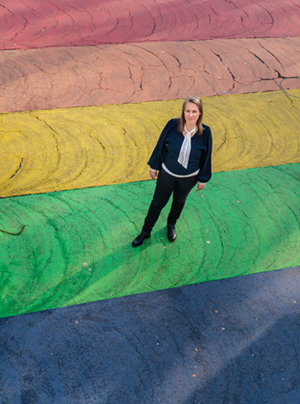De kwetsbaarheid van lhbt'ers

Waarom toch blijven seksualiteit en gender zulke teergevoelige onderwerpen in onze samenleving? Ondanks ons liberale klimaat lopen leden van de lhbt-gemeenschap ook in Nederland vaker dan anderen tegen fysieke of mentale gezondheidsproblemen aan. Laura Baams onderzoekt hoe dat kan.
Tekst: Jurgen Tiekstra / Foto's: Reyer Boxem
Het was tijdens haar studie psychologie in Amsterdam dat Laura Baams erachter kwam dat ze óók op vrouwen valt. Haar identiteit was dus een andere dan ze tot die tijd had gedacht: ze was niet ‘hetero’, maar ‘bi’. ‘In die tijd was ik op zoek naar… ja eigenlijk, naar mijzelf. Ik vond het toen heel interessant om te ontdekken dat hier binnen de wetenschappelijke literatuur artikelen over waren. Als onderzoeker in de dop is het fijn om over jezelf te kunnen lezen.’ Via een promotieonderzoek aan de Universiteit Utrecht ontpopte Baams zich vervolgens tot een ontwikkelingspsycholoog met als focus de mentale gezondheid van lhbt-jongeren. Waarbij deze acroniem ‘lhbt’ (lesbisch, homoseksueel, biseksueel, trans- gender) nog uitgebreid kan worden met de letters ‘q’ (questioning of queer), ‘i’ (inter- sekse) en ‘a’ (a-seksueel of a-romantisch). Soms komt er zelfs nog een ‘+’ achter.
Hiv-preventie
Zowel de lhbt-gemeenschap zelf als het onderzoeksveld zijn nog vrij jong. Baams licht toe: ‘Het sociaal-wetenschappelijk onderzoek, dat een jaar of veertig geleden begon, was erg op hiv en hiv-preventie gericht en daarom met name op mannen die seks hadden met mannen. Ongeacht of ze zich homo noemden of niet. Die blik werd met de tijd uitgebreid naar vrouwen. Later kwam er meer aandacht voor de identiteit van mensen en werden termen als “homo” en ”lesbisch” gebruikt. De “b” kwam erbij omdat onderzoekers erachter kwamen dat er ook mensen waren die zowel met vrouwen als mannen seks hadden en dat een identiteitslabel als biseksueel voor veel mensen passend voelde. Daar komt de wat oudere term “lhb” vandaan, al was er al die tijd natuurlijk ook al genderdiversiteit: genderdiversiteit onder lhb-personen, maar ook onder hetero’s. Vanuit de community zelf was er bovendien het bewustzijn dat de verschillende “letters” wel verschillende ervaringen hebben, maar dat ze gemeen hebben dat ze afgewezen worden vanwege hun seksuele of genderidentiteit. Ze zijn een seksuele of genderminderheid in onze samenleving. Als je dan samen optrekt als het gaat om advocacy, belangenbehartiging, vorm je een grotere groep.’
Uitgescholden
Er is iets paradoxaals aan de hand in de wereld van de lhbt. Een buitenstaander zou denken: in een liberaal en individualistisch land als Nederland is er steeds meer ruimte om te zijn wie je bent. De vlag mag dus uit, want minderheden hebben alle vrijheid om zich te uiten. Zo simpel ligt het niet, vertelt Baams: ‘Wat ik interessant vind, is dat er inderdaad steeds meer sociale acceptatie lijkt voor diversiteit, op het vlak van seksuele oriëntatie en gender, en ook voor etniciteit. Toch vertaalt zich dat nog steeds niet naar afnemend geweld of afnemende gezondheidsproblemen. Als je mensen vraagt: “Wat vind je van die diversiteit?”, zijn ze bijna allemaal positief. Maar kijk je naar de ervaringen van lhbt-personen, dan wordt het nog niet beter: uitgescholden worden neemt niet af, in elkaar geslagen worden neemt nog niet af, gediscrimineerd worden op je werk neemt niet af, gepest worden op school neemt niet af.'
Eerder uit de kast
De mentale gezondheidsproblemen lijken ook niet minder te worden. 'We zien vrij grote verschillen tussen lhbt- en niet-lhbt-groepen als het gaat om mentale gezondheid - depressie, angst, suïcidaliteit. Dat manifesteert zich in een hogere mate van middelengebruik, en zelfs op den duur in fysieke gezondheidsproblemen, die dan weer te maken lijken te hebben met dat middelengebruik of die eerdere mentale gezondheidsproblemen. Ik denk dat hier twee dingen spelen. Eerst dat door de toegenomen sociale acceptatie lhbt-jongeren eerder uit de kast komen en daarmee eerder kwetsbaar zijn. Want als je zichtbaarder bent, maak je meer mee, dan ben je sneller slachtoffer van afwijzing en pesten. Jongeren komen nu bovendien op een moment uit de kast dat ze extra gevoelig zijn voor die afwijzing door hun leeftijdsgenoten. Het gebeurt tegenwoordig vaak in de adolescentie, vanaf veertien of vijftien jaar. Op die leeftijd hebben jongeren niet de mogelijkheid naar een andere school te gaan of een heel andere familie te kiezen, dus ze moeten blijven in de context waarin ze op dat moment leven. Vroeger kwamen mensen uit de kast als ze begin twintig waren, als ze op zichzelf gingen wonen en op dat punt in hun leven in staat waren een accepterend sociaal netwerk op te bouwen.'
Polarisatie
‘Daarnaast denk ik dat de toegenomen sociale acceptatie, en de steeds grotere zichtbaarheid van diversiteit in de media, uitlokt dat mensen die hier negatiever in staan, harder gaan schreeuwen en luider worden. Die polarisatie speelt mogelijk een rol, omdat mensen zich gedwongen voelen een positie in te nemen en zich uit te spreken over dit thema, positief of negatief. Daardoor wordt het ineens duidelijk of jij bijvoorbeeld op een school zit die jou niet wil.’ Opvallend is dat het lot van de ene letter niet hetzelfde is als dat van een andere letter, vertelt Baams. ‘Over het algemeen zie je dat er echt negatiever gereageerd wordt op genderdiversiteit dan op seksuele diversiteit. Dus die t-groep, die maakt het meeste geweld mee, het ernstigste geweld, en heeft als gevolg daarvan de meeste mentale gezondheidsproblemen. Dat is een groep die we vaak meenemen in de lhbt-groep, maar waarvan onderzoekers nu wel zeggen dat dit een groep is die je apart moet nemen bij de analyses.’

‘Biseksuele mannen bestaan niet’
‘Binnen de lhb-groep zien we daarnaast dat de “b” telkens opvalt. Dat is een grote groep, die vaak groter is dan ”l” en “h” samen. We zien specifieke bi-stressoren vanwege vooroordelen die in onze maatschappij spelen. Bijvoorbeeld dat veel mensen denken dat biseksuele mannen niet bestaan. Of dat biseksuele vrouwen eigenlijk in een experimenteerfase zitten en er nog achter moeten komen wie ze “echt” zijn. Deze vooroordelen kloppen niet.’ Waarom toch blijven ‘seksualiteit’ en ‘gender’ zulke teergevoelige onderwerpen in onze samenleving? ‘Je onderdeel voelen van de lhbt-gemeenschap heeft te maken met die seksualiteit, maar ook veel met gender. En gender is een van de eerste factoren waarop baby’s onderscheid kunnen maken. Het verschil zien tussen een man en vrouw, het verschil horen tussen een mannelijke en vrouwelijke stem, en iemand categoriseren als jongen of meisje; dat doen we al vanaf de geboorte. Ik denk dat iedereen die daarvan vervolgens afwijkt, of het nou gaat om hoe je je gedraagt, hoe je je kleedt, of de relaties die je aangaat… als je afwijkt van de vaste patronen die we hebben in onze maatschappij, dan stuit dat op onbegrip of op geweld. Of het valt simpelweg erg op. En als iemand afwijkt van zo’n sociale norm zijn we als maatschappij geneigd te zeggen: waarom is dat, waarom gaat iemand niet mee in de stroom?’
Schoolbeleid
In Nederland is de wetgeving vrij goed in vergelijking met andere landen, maar dat leidt alsnog niet tot een afname van de gezondheidsproblemen. ‘Dat het homohuwelijk is opengesteld en er wetgeving bestaat tegen discriminatie, heeft nog niet veel impact op het leven van lhbt-jongeren gehad.’ Om het leven voor hen makkelijker te maken richt Baams zich met name op scholen. ‘We zien dat leerkrachten op middelbare scholen zelf regelmatig de pester zijn, of ze dat nou expres doen of onbewust. Ik wil weten welk schoolbeleid de beste bijdrage kan leveren, en welke rol de docenten spelen. Daar ga ik de komende jaren onderzoek naar doen.'
Dit artikel is verschenen in het aprilnummer van ons alumnimagazine Broerstraat 5.
Laura Baams (1984) is sinds 2017 assistant professor aan de Faculteit Gedrag en Maatschappijwetenschappen van de RUG. Ze studeerde psychologie aan de Universiteit van Amsterdam. Haar eerste eigen onderzoek naar de lhbt-gemeenschap betrof haar masterscriptie in 2009. Daarna promoveerde ze in 2015 in Utrecht op een onderzoek naar de romantische en seksuele ontwikkeling van adolescenten. Sindsdien richt ze zich weer uitsluitend op de lhbtq-gemeenschap, met onder meer onderzoek in opdracht van de emancipatie-organisatie Bi+ Nederland. Om op de hoogte te blijven van wat jongeren bezighoudt, is ze lid geworden van TikTok.
Meer nieuws
-
08 december 2025
Burgerparticipatie onmisbaar voor een duurzame energietoekomst
-
23 oktober 2025
Negen wetenschappers van de RUG ontvangen Vidi-beurs
